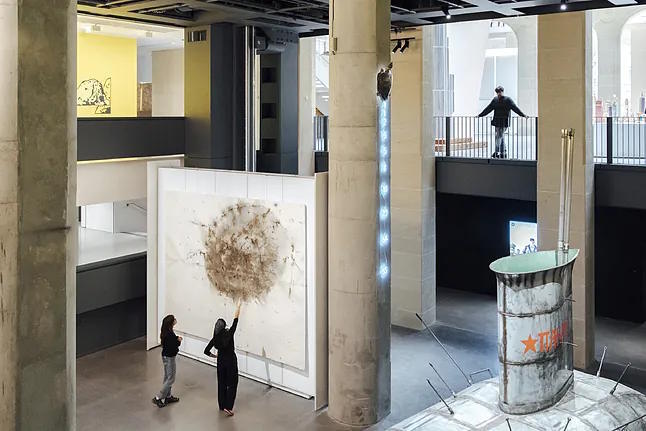200 meters from the Louvre pyramid, in the shadow of the Palais-Royal, the new Parisian icon of modern art has emerged. The Cartier Foundation opens its doors on October 25 with a General Exhibition featuring a hundred artists (Damien Hirst, Matthew Barney, Juan Muñoz, Giussepe Penone, Hu Liu, Olga de Amaral) in a space reimagined by Jean Nouvel to maximize the "exhibition experience."
"There are no walls, no floor, no ceiling." That has been the approach of the architect of the Agbar Tower in Barcelona and the extension of the Reina Sofía in Madrid. "Everything is unlimited and transformable. Everything is capable of moving."
"We haven't invented modular architecture at this point, but I believe we have been able to take it to a higher level in service of art," warns curator Grazia Quaroni. "It is a building in constant metamorphosis, which will be able to adapt to each exhibition and event."
The original building was designed in 1854 by Alfred Armand in perfect alignment with Baron Haussman's Paris. Until 1887, it was the Grand Hôtel du Louvre and hosted thousands of visitors from the universal exhibitions before becoming the Grand Magasins du Louvre and the Louvre des Antiquaires. The Cartier Foundation was looking for a more emblematic place to leave Boulevard Raspail and exhibit its collections of modern art in the heart of Paris. And the opportunity came from the sky.
"Being next to the Louvre is almost a dream," acknowledges Grazia Quaroni, highlighting Jean Nouvel's own eagerness to open large windows to capture the constant flow of people and have the feeling that the space expands outward. Although the best-kept secret is inside, with five mobile platforms that can be anchored in eleven different vertical positions, allowing the 6,500 square meters of exhibition space to be adapted to countless variations. The Italian studio Formafantasma has become an integral part of the General Exhibition, working closely with the architect.
"We are facing an exhibition that breathes," emphasizes the curator. "We wanted to give visitors a lot of freedom, so they don't feel constrained, and we have also placed a lot of emphasis on interdisciplinarity and dialogue between artists." The General Exhibition progresses in four thematic strands: architecture, nature, crafts, and science. From Damien Hirst's blooming almond trees to Bruno Novelli's jungle visions, Olga de Amaral's textile waterfall, or Jean-Michel Alberola's murals, all the way to Panamarenko's submarine and Moebius's imaginary worlds.
There are also several underlying narrative threads such as the environment, migratory flows, the threat of wars... Philosopher Paul Virilio surprises with his black and white photographs of bunkers on the Normandy coast; the Diller Scofidio+Renfro studio immerses us in an installation, EXIT, about the unsettling future of a warmer world, and Luiz Zerbini invites reflection on "the spiritual nature of reality" with plants as the basis of his installations.
Grazia Quaroni invites us to open ourselves to the unexpected and leave all expectations about what to find in an art exhibition at the doors of the renewed Cartier Foundation. Finally, we ask if the ambition is to compete with the Louis Vuitton Foundation or fill the void that the closure of the Pompidou Center will leave in the center of Paris for five years. "Beaubourg will fly again," she assures. "And Paris will continue to enrich itself with new spaces to approach contemporary art."
